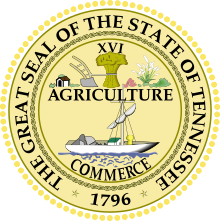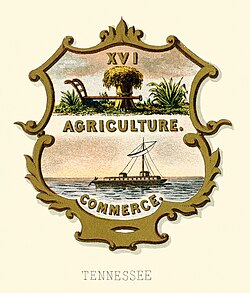| The Great Seal of Tennessee | |
|---|---|
 | |
| Versions | |
 | |
| Armiger | State of Tennessee |
| Adopted | September 25, 1801 |
| Motto | 'Agriculture,' 'Commerce' |
The Great Seal of Tennessee is the official government emblem of the U.S. state of Tennessee.
| The Great Seal of Tennessee | |
|---|---|
 | |
| Versions | |
 | |
| Armiger | State of Tennessee |
| Adopted | September 25, 1801 |
| Motto | 'Agriculture,' 'Commerce' |
The Great Seal of Tennessee is the official government emblem of the U.S. state of Tennessee.
The Roman numerals XVI, representing Tennessee as the 16th state to enter the United States, are found at the top of the Great Seal.[ citation needed ] Images of a plow, a bundle of wheat, a cotton plant, and the word "Agriculture" below the three images occupying the center of the seal. [1] Wheat and cotton were, and still are, important cash crops grown in the state.[ citation needed ]
The lower half of the Great Seal originally displayed a boat and a boatman with the word "Commerce" underneath, but was changed to a flat-bottomed riverboat without a boatman subsequently. River trade was important to the state due to three large rivers: the Tennessee River, the Cumberland River, and the Mississippi River; the boat continues to represent the importance of commerce to the state. [1] Surrounding the images in the original design were the words "The Great Seal of the State of Tennessee" and "Feb. 6th, 1796". The month and day have been dropped in the modern design.[ citation needed ]
The Great Seal is provided for in the Tennessee Constitution of 1796. The design, however, was not undertaken until September 25, 1801. [2] [1] Wheat and cotton were, and still are, important cash crops grown in the state. In 1987, the Tennessee General Assembly adopted a standardized version of the seal that updated its look and appearance. [2] The seal is kept by the Secretary of State and the Governor for official use on state documents, such as legislation, commissions, and proclamations.[ citation needed ]
The seal of the state changed over time.


A cereal is any grass cultivated for its edible grain, which is composed of an endosperm, a germ, and a bran. Cereal grain crops are grown in greater quantities and provide more food energy worldwide than any other type of crop and are therefore staple crops. They include rice, wheat, rye, oats, barley, millet, and maize. Edible grains from other plant families, such as buckwheat, quinoa, and chia, are referred to as pseudocereals.

Winter wheat are strains of wheat that are planted in the autumn to germinate and develop into young plants that remain in the vegetative phase during the winter and resume growth in early spring. Classification into spring wheat versus winter wheat is common and traditionally refers to the season during which the crop is grown. For winter wheat, the physiological stage of heading is delayed until the plant experiences vernalization, a period of 30 to 60 days of cold winter temperatures.

A cash crop, also called profit crop, is an agricultural crop which is grown to sell for profit. It is typically purchased by parties separate from a farm. The term is used to differentiate marketed crops from staple crop in subsistence agriculture, which are those fed to the producer's own livestock or grown as food for the producer's family.

The Great Seal of the State of Georgia is a device that has historically been used to authenticate government documents executed by the state of Georgia. The first great seal of the state was specified in the State Constitution of 1777, and its current form was adopted in 1799 with alterations in 1914. Its specifications are currently spelled out by statute.

The Seal of the Commonwealth of Virginia is the official seal of the Commonwealth of Virginia, a U.S. state. The state flag of Virginia consists of the obverse of the seal against a blue background. A state flag was first adopted at the beginning of the American Civil War in April 1861, readopted in 1912, and standardized by the General Assembly in February 1950. The standing allegorical female figure of virtue is shown having vanquished tyranny, symbolized by a fallen king at her feet. She has an exposed breast in the manner of classical depictions of Amazons, making this the only state flag in the U.S. depicting a form of nudity. The motto Sic semper tyrannis means "Thus always to tyrants." The flag may be decorated with a white fringe along the fly edge; this is usually done when the flag is displayed indoors.

The history of agriculture in the United States covers the period from the first English settlers to the present day. In Colonial America, agriculture was the primary livelihood for 90% of the population, and most towns were shipping points for the export of agricultural products. Most farms were geared toward subsistence production for family use. The rapid growth of population and the expansion of the frontier opened up large numbers of new farms, and clearing the land was a major preoccupation of farmers. After 1800, cotton became the chief crop in southern plantations, and the chief American export. After 1840, industrialization and urbanization opened up lucrative domestic markets. The number of farms grew from 1.4 million in 1850, to 4.0 million in 1880, and 6.4 million in 1910; then started to fall, dropping to 5.6 million in 1950 and 2.2 million in 2008.

The great seal of the state of Delaware was first adopted on January 17, 1777, with the current version being adopted April 29, 2004. It contains the state coat of arms surrounded by an inscription.

The Great Seal of Oklahoma was officially adopted in 1907 and is used to authenticate certain documents issued by the Government of Oklahoma. The phrase is used both for the physical seal itself, which is kept by the Secretary of State, and more generally for the design impressed upon it.

The state emblem of Uzbekistan was formally adopted on July 2, 1992 by the newly establish Republic of Uzbekistan. It bears many similarities to the emblem of the previous Uzbek SSR, which Republic of Uzbekistan succeeded. Like other post-Soviet republics whose symbols do not predate the October Revolution, the current emblem retains some components of the Soviet one. Prior to 1992, Uzbekistan had an emblem similar to all other Soviet Republics, with standard communist emblems and insignia.

The Great Seal of the State of Iowa was created in 1847 and depicts a citizen soldier standing in a wheat field surrounded by symbols including farming, mining, and transportation with the Mississippi River in the background. An eagle overhead bears the state motto.

The Great Seal of the State of Nebraska was adopted by the Nebraska legislature on June 15, 1867. It depicts a blacksmith working at an anvil along with various other symbols related to Nebraska during the early days of its statehood.

The Great Seal of the State of Ohio is the official insignia of the U.S. state of Ohio. All governmental offices, agencies, and courts in Ohio use variations of the state seal. Its primary feature is a circular coat of arms that depicts a sunrise in Chillicothe, Ohio's first capital, along with symbols of the state's origins. The seal sometimes appears with the state motto, "With God, All Things Are Possible".

The Great Seal of the Commonwealth of Pennsylvania is the state seal for the Commonwealth of Pennsylvania. According to the state's website, the seal was authorized by the Pennsylvania General Assembly in 1791, and is "a symbol of authenticity which verifies that proclamations, commissions and other papers of state are legal and official."

Bahawalpur District is a district of Punjab, Pakistan, with capital the city of Bahawalpur. According to the 1998 Census it had a population of 2,433,091, of which 27.01% were urban. Bahawalpur district covers 24,830 km2. Approximately two-thirds of the district (16,000 km2) is covered by the Cholistan Desert, which extends into the Thar Desert of India. The district is a major producer of cotton.

The Grand Divisions are three geographic regions in the U.S. state of Tennessee, each constituting roughly one-third of the state's land area, that are geographically, culturally, legally, and economically distinct. The Grand Divisions are legally recognized in the state constitution and state law and are represented on the flag of Tennessee by the flag's three prominent stars.

For millennia, agriculture has played an important role in the Chinese economy and society. By the time the People's Republic of China was established in 1949, virtually all arable land was under cultivation; irrigation and drainage systems constructed centuries earlier and intensive farming practices already produced relatively high yields. But little prime virgin land was available to support population growth and economic development. However, after a decline in production as a result of the Great Leap Forward (1958–60), agricultural reforms implemented in the 1980s increased yields and promised even greater future production from existing cultivated land.

The Cotton Belt is a region of the Southern United States where cotton was the predominant cash crop from the late 18th century into the 20th century.

In 2020, approximately 80% of Chad's labor force was employed in the agricultural sector. This sector of the economy accounts for 52.3% of the GDP, as of 2017. With the exception of cotton production, some small-scale sugar cane production, and a portion of the peanut crop, Chad's agriculture consists of subsistence food production.

Throughout its history, agriculture in Paraguay has been the mainstay of the economy. This trend has continued today and in the late 1980s the agricultural sector generally accounted for 48 percent of the nation's employment, 23 percent of GDP, and 98 percent of export earnings. The sector comprised a strong food and cash crop base, a large livestock subsector including cattle ranching and beef production, and a vibrant timber industry.

The flag of Knoxville, Tennessee was officially adopted by municipal ordinance on October 16, 1896. It is the third oldest official city flag in the United States and the oldest flag of any state or city governmental entity in Tennessee.